
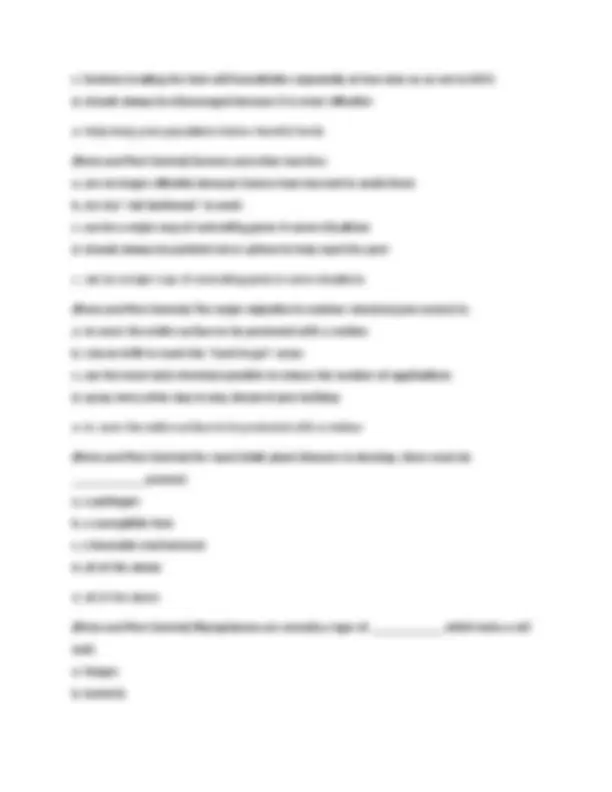


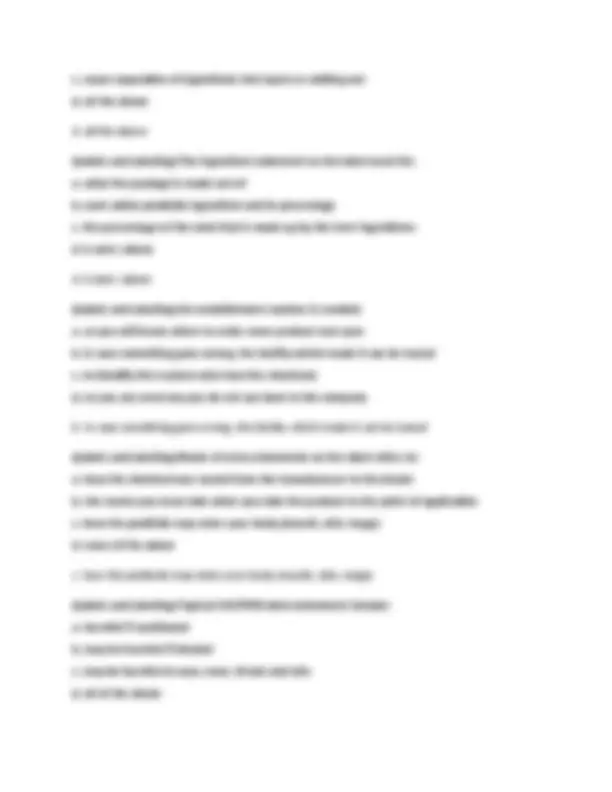
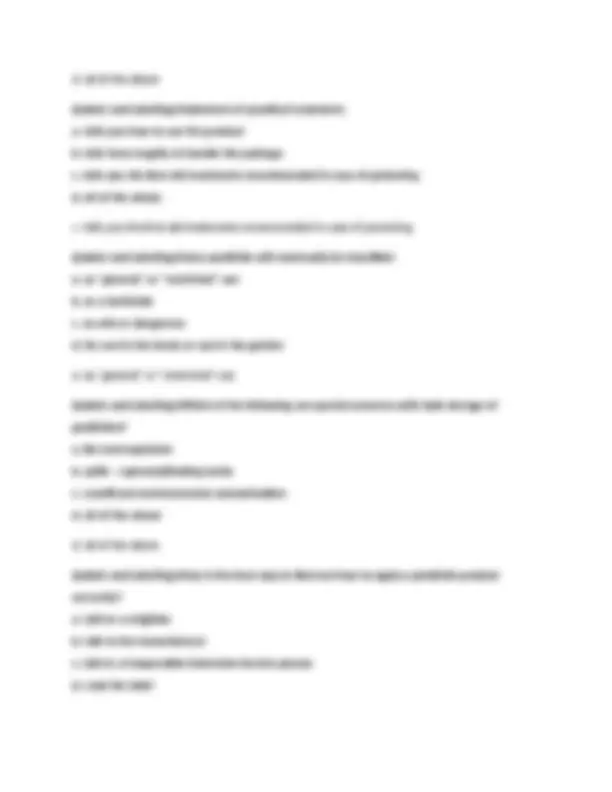
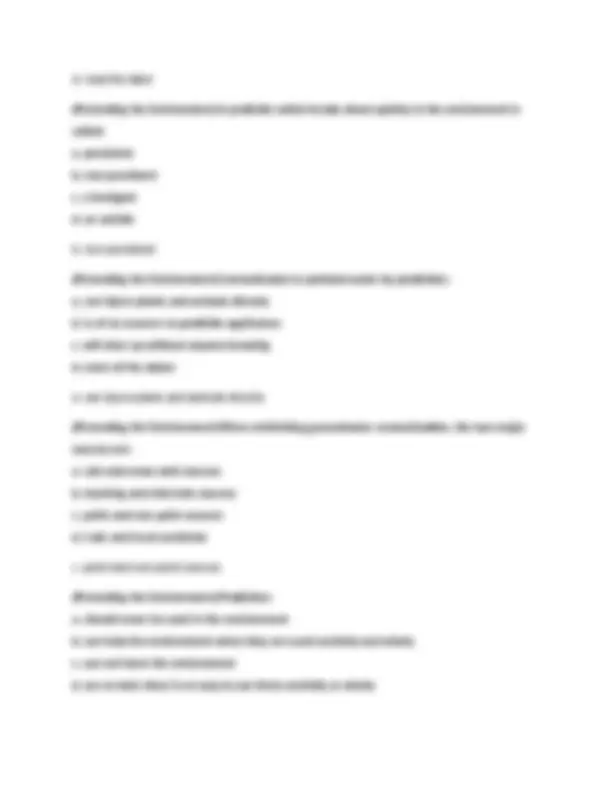
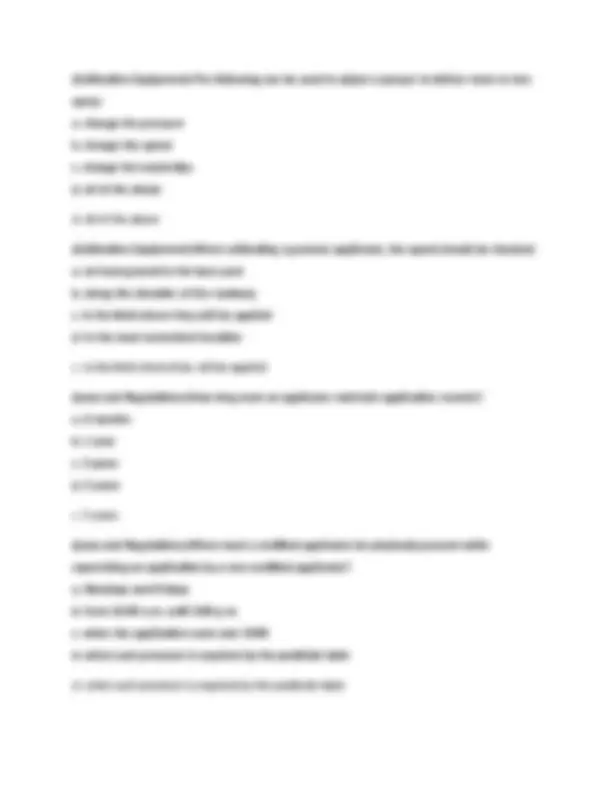
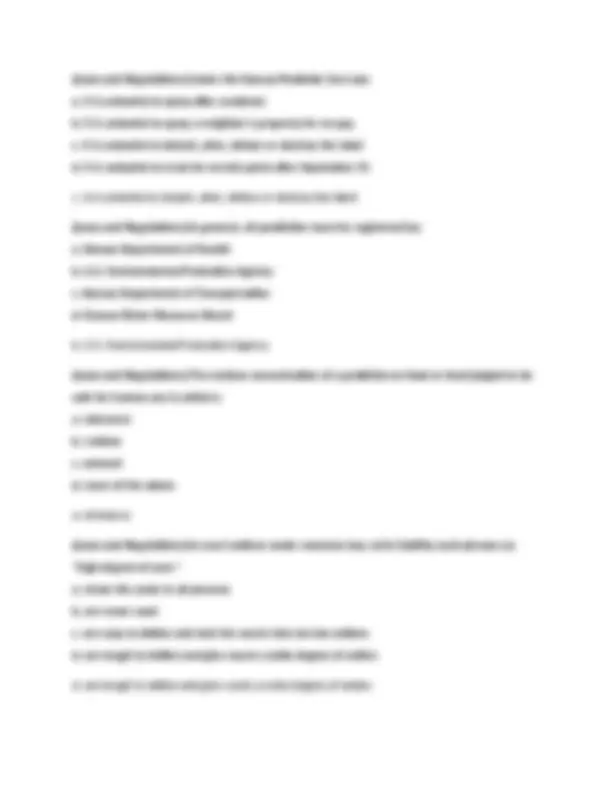



Study with the several resources on Docsity

Earn points by helping other students or get them with a premium plan


Prepare for your exams
Study with the several resources on Docsity

Earn points to download
Earn points by helping other students or get them with a premium plan
Community
Ask the community for help and clear up your study doubts
Discover the best universities in your country according to Docsity users
Free resources
Download our free guides on studying techniques, anxiety management strategies, and thesis advice from Docsity tutors
KANSAS COMMERCIAL PESTICIDE APPLICATOR 2025 ACTUAL EXAM QUESTIONS WITH 100% CORRECT ANSWERS GRADED A+ KANSAS COMMERCIAL PESTICIDE APPLICATOR 2025 ACTUAL EXAM QUESTIONS WITH 100% CORRECT ANSWERS GRADED A+ KANSAS COMMERCIAL PESTICIDE APPLICATOR 2025 ACTUAL EXAM QUESTIONS WITH 100% CORRECT ANSWERS GRADED A+ KANSAS COMMERCIAL PESTICIDE APPLICATOR 2025 ACTUAL EXAM QUESTIONS WITH 100% CORRECT ANSWERS GRADED A+ KANSAS COMMERCIAL PESTICIDE APPLICATOR 2025 ACTUAL EXAM QUESTIONS WITH 100% CORRECT ANSWERS GRADED A+ KANSAS COMMERCIAL PESTICIDE APPLICATOR 2025 ACTUAL EXAM QUESTIONS WITH 100% CORRECT ANSWERS GRADED A+ KANSAS COMMERCIAL PESTICIDE APPLICATOR 2025 ACTUAL EXAM QUESTIONS WITH 100% CORRECT ANSWERS GRADED A+
Typology: Exams
1 / 17

This page cannot be seen from the preview
Don't miss anything!










(Pests and Pest Control) Natural forces are important because: a. you cannot do anything about them b. they can cause pest populations to rise and fall c. you can never spray anywhere in the winter time d. the rain and wind always makes it necessary to respray the area b. they can cause pest populations to rise and fall (Pests and Pest Control) Biological control: a. is always 100% effective b. is never complete c. never occurs naturally d. always interferes with commercial chemical control operations b. is never complete (Pests and Pest Control) Resistance to pesticides develops in pests species: a. because some applicators use the least expensive chemicals b. the chemical companies plan it to happen c. the pesticides are not poison enough d. rarely does any pesticide kill all the pests and those that survive pass this ability on to their offspring d. rarely does any pesticide kill all the pests and those that survive pass this ability on to their offspring (Pests and Pest Control) Integrated Pest Management practices include the use of: a. chemical pesticides
b. cultivation and barriers c. sanitation and traps d. all of the above d. all of the above (Pests and Pest Control) In the case of insects: a. they are only important because they give entomologists something to talk about b. they must all be killed as soon as possible c. about 99% of all species are of minor importance d. they all feed on plants which could be eaten by people c. about 99% of all species are of minor importance (Pests and Pest Control) The insect thorax: a. is where the insect antennae are located b. supports the legs and wings (if present) of the adult insect c. is always a very small orange spot on right side of the head d. is difficult to distinguish from the legs b. supports the legs and wings (if present) of the adult insect (Pests and Pest Control) An example of an Arachnid is: a. a butterfly b. an insect c. a spider d. a pigweed c. a spider (Pests and Pest Control) The use of host resistance: a. helps keep pest populations below harmful levels b. means that any pesticide use will not result in killing the host
c. virus d. nematode b. bacteria (Pests and Pest Control) Root knot, soybean cyst, and pine wilt are examples of ____________ diseases. a. nematode b. fungus c. bacteria d. virus a. nematode (Pests and Pest Control) Quarantines that regulate the movement of plants into this country are a form of disease control called: a. avoidance b. protection c. exclusion d. eradication c. exclusion (Pests and Pest Control) Weeds interfere with crop production by: a. competing for water b. harboring pest insects, mites etc. c. releasing toxins into the soil d. all of the above d. all of the above (Pests and Pest Control) All plants, including weeds, have how many stages of growth? a. 1 b. 2
c. 3 d. 4 d. 4 (Pests and Pest Control) An aquatic plant without a true stem, leaves or vascular system is called: a. broadleaf weed b. annual grass c. algae d. fungi c. algae (Pests and Pest Control) Controlling weeds usually involves: a. visiting with a neighbor b. the use of livestock to pack the soil so the seedlings can not emerge c. taking advantage of the differences between the weeds and desired species d. burning the soil surface with a combination of chemicals c. taking advantage of the differences between the weeds and desired species (Pests and Pest Control) Chemicals used to control weeds are pesticides called: a. rodenticides b. miticides c. insecticides d. herbicides d. herbicides (Pests and Pest Control) Snails and slugs are in a group of animals called: a. herbivores b. carnivores
c. 6 to 10% active ingredient d. 11 to 15% active ingredient a. 1% or less active ingredient (Pesticide Formulations) Pesticide formulations which form a gas when applied are called: a. aerosols b. fumigants c. fungicides d. flowables b. fumigants (Pesticide Formulations) An advantage of pelleted formulations is: a. drift hazard is low b. no mixing - ready to use c. excellent distribution due to the uniform size d. all of the above d. all of the above (Pesticide Formulations) A finely ground formulation which looks like a dust, is mixed in water but does not dissolve in the water is called: a. sprayable concentrate b. emulsifiable concentrate c. soluble powder d. wettable powder d. wettable powder (Pesticide Formulations) Pesticides which are not compatible can: a. cause loss of effectiveness if mixed b. cause injury to treated surfaces, animals, plants, etc.
c. cause separation of ingredients into layers or settling out d. all the above d. all the above (Labels and Labeling) The ingredient statement on the label must list: a. what the package is made out of b. each active pesticide ingredient and its percentage c. the percentage of the total that is made up by the inert ingredients d. b and c above d. b and c above (Labels and Labeling) An establishment number is needed: a. so you will know where to order more product next year b. in case something goes wrong, the facility which made it can be traced c. to identify the truckers who haul the chemicals d. so you can send any you do not use back to the company b. in case something goes wrong, the facility which made it can be traced (Labels and Labeling) Route of entry statements on the label refers to: a. how the chemical was routed from the manufacturer to the dealer b. the routes you must take when you take the product to the point of application c. how the pesticide may enter your body (mouth, skin, lungs) d. none of the above c. how the pesticide may enter your body (mouth, skin, lungs) (Labels and Labeling) Typical CAUTION label statements include: a. harmful if swallowed b. may be harmful if inhaled c. may be harmful to eyes, nose, throat and skin d. all of the above
d. read the label (Protecting the Environment) A pesticide which breaks down quickly in the environment is called: a. persistent b. non-persistent c. a fumigant d. an avicide b. non-persistent (Protecting the Environment) Contaminated or polluted water by pesticides: a. can injure plants and animals directly b. is of no concern to pesticide applicators c. will clear up without anyone knowing d. none of the above a. can injure plants and animals directly (Protecting the Environment) When minimizing groundwater contamination, the two major sources are: a. rain and snow-melt sources b. leaching and sink-hole sources c. point and non-point sources d. train and truck accidents c. point and non-point sources (Protecting the Environment) Pesticides: a. should never be used in the environment b. can help the environment when they are used carefully and wisely c. can not harm the environment d. are so toxic there is no way to use them carefully or wisely
b. can help the environment when they are used carefully and wisely (Application Equipment) What must you do in terms of application equipment? a. see your banker b. make a purchase before the price goes up c. select the right kind of equipment d. talk with a neighbor c. select the right kind of equipment (Application Equipment) The letters, "ULV" stand for: a. unusually large volume b. ultimate land value c. ultra low volume d. unlimited livestock versatility c. ultra low volume (Application Equipment) Spray nozzles are made out of: a. brass b. stainless steel c. nylon d. all of the above d. all of the above (Application Equipment) When you change chemicals in your sprayer, you should: a. clean the sprayer thoroughly b. just fill the tank with the new chemical and continue to spray c. put the new chemical in before the tank is empty to avoid getting air in the lines d. let the sprayer sit for two days to let it dry out a. clean the sprayer thoroughly
(Calibration Equipment) The following can be used to adjust a sprayer to deliver more or less spray: a. change the pressure b. change the speed c. change the nozzle tips d. all of the above d. all of the above (Calibration Equipment) When calibrating a granular applicator, the speed should be checked: a. on hard ground in the barn yard b. along the shoulder of the roadway c. in the field where they will be applied d. in the most convenient location c. in the field where they will be applied (Laws and Regulations) How long must an applicator maintain application records? a. 6 months b. 1 year c. 3 years d. 5 years c. 3 years (Laws and Regulations) When must a certified applicator be physically present while supervising an application by a non-certified applicator? a. Mondays and Fridays b. from 10:00 a.m. until 3:00 p.m. c. when the application costs over $ d. when such presence is required by the pesticide label d. when such presence is required by the pesticide label
(Laws and Regulations) Under the Kansas Pesticide Use Law: a. it is unlawful to spray after sundown b. it is unlawful to spray a neighbor's property for no pay c. it is unlawful to detach, alter, deface or destroy the label d. it is unlawful to treat for certain pests after September 31 c. it is unlawful to detach, alter, deface or destroy the label (Laws and Regulations) In general, all pesticides must be registered by: a. Kansas Department of Health b. U.S. Environmental Protection Agency c. Kansas Department of Transportation d. Kansas Water Resource Board b. U.S. Environmental Protection Agency (Laws and Regulations) The residue concentration of a pesticide on food or feed judged to be safe for human use is called a: a. tolerance b. residue c. amount d. none of the above a. tolerance (Laws and Regulations) In court actions under common law, strict liability such phrases as "high degree of care:" a. mean the same to all persons b. are never used c. are easy to define and lock the courts into narrow actions d. are tough to define and give courts a wide degree of action d. are tough to define and give courts a wide degree of action
(Pesticide Safety) When should you change filters and cartridges on your respirator? a. if you have trouble breathing b. if you smell pesticides c. after a maximum of 8 hours of use d. all of the above d. all of the above (Pesticide Safety) As soon as pesticides arrive for storage you should: a. store them in the designated place b. mark them with an "X' for storage c. remove the label so it will not get lost d. pack them in an absorbent material a. store them in the designated place (Pesticide Safety) Closed handling systems are designed to remove pesticide concentrate from the original container by: a. gravity b. suction c. high pressure d. a and b above d. a and b above (Pesticide Safety) Before applying a pesticide, you must: a. be paid for the job b. clear the area of all unprotected persons c. get the neighbor's approval d. be sure with treated surface will dry within 30 minutes b. clear the area of all unprotected persons
(Pesticide Safety) The best way to solve the problem of pesticide waste disposal is: a. dump it out along the road b. pour it out in back of the shed c. simply avoid producing any d. bury it on the neighbor's property c. simply avoid producing any (Pesticide Safety) In the case of minor pesticide spills, you should: a. keep people away b. confine the spill c. dispose of it as you would d. all of the above d. all of the above (Pesticide Safety) The initial effort to help a poisoned victim is: a. respiration b. transfusion c. first aid d. circulation c. first aid (Pesticide Safety) In the case of poison in the eye, you should: a. keep the eye closed for 30 minutes b. wash the eye quickly for 15 minutes with running water c. put your goggles on to keep dust and dirt out d. cover the eye with black cloth to keep all light out e. all of the above b. wash the eye quickly for 15 minutes with running water